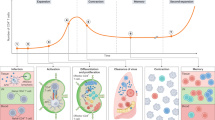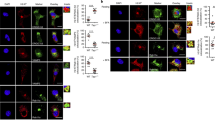Abstract
Dendritic cells (DCs) secrete vesicles of endosomal origin, called exosomes, that bear major histocompatibility complex (MHC) and T cell costimulatory molecules. Here, we found that injection of antigen- or peptide-bearing exosomes induced antigen-specific naïve CD4+ T cell activation in vivo. In vitro, exosomes did not induce antigen-dependent T cell stimulation unless mature CD8α− DCs were also present in the cultures. These mature DCs could be MHC class II–negative, but had to bear CD80 and CD86. Therefore, in addition to carrying antigen, exosomes promote the exchange of functional peptide-MHC complexes between DCs. Such a mechanism may increase the number of DCs bearing a particular peptide, thus amplifying the initiation of primary adaptive immune responses.
This is a preview of subscription content, access via your institution
Access options
Subscribe to this journal
Receive 12 print issues and online access
$209.00 per year
only $17.42 per issue
Buy this article
- Purchase on Springer Link
- Instant access to full article PDF
Prices may be subject to local taxes which are calculated during checkout







Similar content being viewed by others
References
Thery, C., Zitvogel, L. & Amigorena, S. Exosomes: composition, biogenesis and function. Nature Rev. Immunol. 2, 569–579 (2002).
Stoorvogel, W., Kleijmeer, M.J., Geuze, H.J. & Raposo, G. The biogenesis and functions of exosomes. Traffic 3, 321–330 (2002).
Thery, C. et al. Proteomic analysis of dendritic cell-derived exosomes: a secreted subcellular compartment distinct from apoptotic vesicles. J. Immunol. 166, 7309–7318 (2001).
Thery, C. et al. Molecular characterization of dendritic cell-derived exosomes. Selective accumulation of the heat shock protein hsc73. J. Cell Biol. 147, 599–610 (1999).
Boucheix, C. & Rubinstein, E. Tetraspanins. Cell. Mol. Life Sci. 58, 1189–1205 (2001).
Gahmberg, C.G. Leukocyte adhesion: CD11/CD18 integrins and intercellular adhesion molecules. Curr. Opin. Cell Biol. 9, 643–650 (1997).
Stubbs, J.D. et al. cDNA cloning of a mouse mammary epithelial cell surface protein reveals the existence of epidermal growth factor-like domains linked to factor VIII-like sequences. Proc. Natl. Acad. Sci. USA 87, 8417–8421 (1990).
Srivastava, P. Interaction of heat shock proteins with peptides and antigen presenting cells: Chaperoning of the innate and adaptive immune responses. Annu. Rev. Immunol. 20, 395–425 (2002).
Raposo, G. et al. B lymphocytes secrete antigen-presenting vesicles. J. Exp. Med. 183, 1161–1172 (1996).
Zitvogel, L. et al. Eradication of established murine tumors using a novel cell-free vaccine: dendritic cell-derived exosomes. Nature Med. 4, 594–600 (1998).
Lantz, O., Grandjean, I., Matzinger, P. & Di Santo, J.P. γ chain required for naive CD4+ T cell survival but not for antigen proliferation. Nature Immunol. 1, 54–58 (2000).
Scott, D. et al. Dendritic cells permit identification of genes encoding MHC class II-restricted epitopes of transplantation antigens. Immunity 12, 711–720 (2000).
Winzler, C. et al. Maturation stages of mouse dendritic cells in growth factor-dependent long-term cultures. J. Exp. Med. 185, 317–328 (1997).
Wolfers, J. et al. Tumor-derived exosomes are a source of shared tumor rejection antigens for CTL cross-priming. Nature Med. 7, 297–303 (2001).
Shortman, K. & Liu, Y.J. Mouse and human dendritic cell subtypes. Nature Rev. Immunol. 2, 151–161 (2002).
Maldonado-Lopez, R. & Moser, M. Dendritic cell subsets and the regulation of Th1/Th2 responses. Semin. Immunol. 13, 275–282 (2001).
De Smedt, T. et al. CD8α− and CD8α+ subclasses of dendritic cells undergo phenotypic and functional maturation in vitro and in vivo. J. Leukoc. Biol. 69, 951–958 (2001).
Gray, D., Kosco, M. & Stockinger, B. Novel pathways of antigen presentation for the maintenance of memory. Int. Immunol. 3, 141–148 (1991).
Sharrow, S.O., Mathieson, B.J. & Singer, A. Cell surface appearance of unexpected host MHC determinants on thymocytes from radiation bone marrow chimeras. J. Immunol. 126, 1327–1335 (1981).
Zimmer, J., Ioannidis, V. & Held, W. H-2D ligand expression by Ly49A+ natural killer (NK) cells precludes ligand uptake from environmental cells: implications for NK cell function. J. Exp. Med. 194, 1531–1539 (2001).
Sjostrom, A. et al. Acquisition of external major histocompatibility complex class I molecules by natural killer cells expressing inhibitory Ly49 receptors. J. Exp. Med. 194, 1519–1530 (2001).
Mack, M. et al. Transfer of the chemokine receptor CCR5 between cells by membrane-derived microparticles: a mechanism for cellular human immunodeficiency virus 1 infection. Nature Med. 6, 769–775 (2000).
Greco, V., Hannus, M. & Eaton, S. Argosomes: a potential vehicle for the spread of morphogens through epithelia. Cell 106, 633–645 (2001).
Denzer, K. et al. Follicular dendritic cells carry MHC class II-expressing microvesicles at their surface. J. Immunol. 165, 1259–1265 (2000).
Andre, F. et al. Malignant effusions and immunogenic tumour-derived exosomes. Lancet 360, 295–305 (2002).
Wulfing, C. et al. Costimulation and endogenous MHC ligands contribute to T cell recognition. Nature Immunol. 3, 42–47 (2002).
Kumaraguru, U., Rouse, R.J., Nair, S.K., Bruce, B.D. & Rouse, B.T. Involvement of an ATP-dependent peptide chaperone in cross-presentation after DNA immunization. J. Immunol. 165, 750–759 (2000).
Turley, S.J. et al. Transport of peptide-MHC class II complexes in developing dendritic cells. Science 288, 522–527 (2000).
Moron, G., Rueda, P., Casal, I. & Leclerc, C. CD8α− CD11b+ dendritic cells present exogenous virus-like particles to CD8+ T cells and subsequently express CD8α and CD205 molecules. J. Exp. Med. 195, 1233–1245 (2002).
Prina, E., Lang, T., Glaichenhaus, N. & Antoine, J.-C. Presentation of the protective parasite antigen LACK by Leishmania-infected macrophages. J. Immunol. 156, 4318–4327 (1996).
Acknowledgements
We thank Z. Maciorowski for help with cell sorting, C. Hivroz and A. Sarukhan for critical reading of the manuscript, G. Raposo and L. Zitvogel for helpful discussions and P. Ricciardi-Castagnoli for the D1 cell line. Supported by Institut Curie, INSERM and Anosys Inc. with grants from Association pour la Recherche sur le Cancer (grant number 5913), Ministère de la Recherche (ACI number 4219) and European Community (grant number QoL-2001-00093).
Author information
Authors and Affiliations
Corresponding author
Ethics declarations
Competing interests
S. A. is a consultant for and shareholder of the company ANOSYS, which is developing the use of exosomes for immunotherapy.
Rights and permissions
About this article
Cite this article
Théry, C., Duban, L., Segura, E. et al. Indirect activation of naïve CD4+ T cells by dendritic cell–derived exosomes. Nat Immunol 3, 1156–1162 (2002). https://doi.org/10.1038/ni854
Received:
Accepted:
Published:
Issue Date:
DOI: https://doi.org/10.1038/ni854
This article is cited by
-
Multimodal probing of T-cell recognition with hexapod heterostructures
Nature Methods (2024)
-
Exosome: From biology to drug delivery
Drug Delivery and Translational Research (2024)
-
Adipose-derived stem cell exosomes promote tumor characterization and immunosuppressive microenvironment in breast cancer
Cancer Immunology, Immunotherapy (2024)
-
Stem Cells and Regenerative Strategies for Wound Healing: Therapeutic and Clinical Implications
Current Pharmacology Reports (2024)
-
Mesenchymal stem cells and dental implant osseointegration during aging: from mechanisms to therapy
Stem Cell Research & Therapy (2023)



